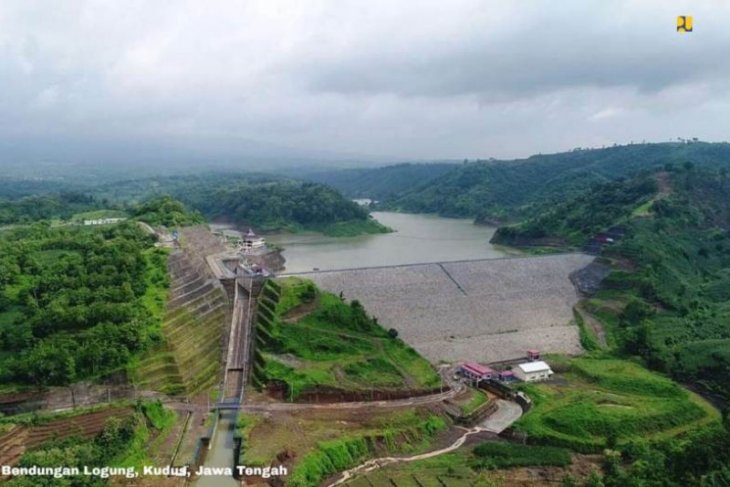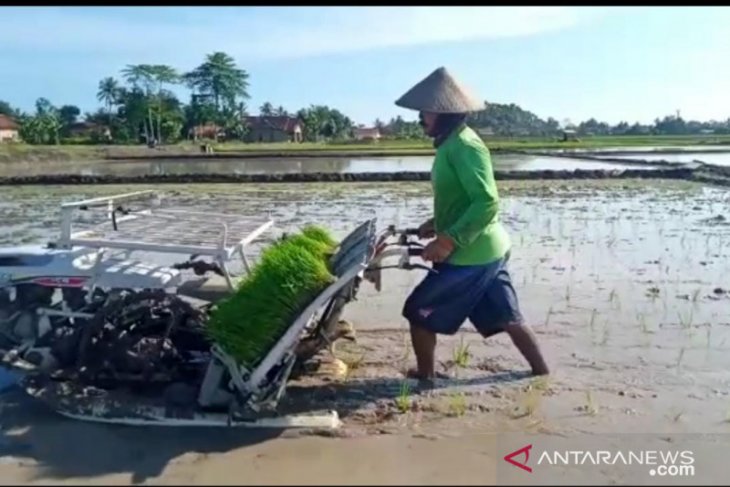Live Streaming
Program Highlight
Company Profile
May
Government to Raise Water Storage Infrastructure Capacity against Drought
Written by Ani Hasanah
Logung Dam in Kudus, Central Java. (ANTARA/HO- Kementerian PUPR)
The Ministry of Public Works and Public Housing (PUPR) will optimize the capacity of water storage infrastructure across Indonesia as a precautionary measure against protracted drought during the dry season.
PUPR Minister Basuki Hadimuljono highlighted President Joko Widodo's instructions that the government should guarantee water supply for food, health, and basic services during the COVID-19 pandemic.
"Hence, the Ministry of PUPR will adopt measures to guarantee the availability of water during the dry season," Minister Hadimuljono noted in a statement here on Friday.
Field monitoring results indicated that 241 reservoirs cover 16 main reservoirs holding 4,721 billion cubic meters of water to supply to irrigation areas measuring 512,515 hectares, or 96.57 percent of the total 530,738 hectares.
Of the 16 main reservoirs, 10 reservoirs with normal water levels are Jatiluhur, Cirata, Saguling, Batutegi, Sutami, Wonorejo, Bili-Bili, Kalola, Way Rarem, and Ponre-Ponre.
Meanwhile, six reservoirs holding below-normal levels of water are Kedungombo, Wonogiri, Wadas Lintang, Cacaban, Selorejo, and Batu Bulan.
In addition to the dams, the Ministry of PUPR monitors water availability in 4,227 retention basins and 344 weirs, with a volume capacity of 338.8 cubic meters.
Moreover, the ministry has readied 7,914 bore wells by utilizing an irrigation network of groundwater and raw water spanning an area of 118,652 hectares and groundwater for raw water of 2,386 cubic meters per second. Of the total, 4,098 bore wells are functioning normally, while operational disruptions are being encountered in the remaining 3,816 bore wells.
Of the 4,098 normally functioning bore wells, 488 are located in Sumatra, while 46 wells are in Kalimantan, 701 in Sulawesi, 1,514 in Java, 1,190 in Bali-Nusa Tenggara, two in Maluku, and 148 wells in Papua.
The Meteorology, Climatology, and Geophysics Agency (BMKG) has projected this year’s dry season to occur in April, dominant in May, June, and July, while peaking during the period from August to September 2020.
The hydrological drought is forecast to chiefly impact 10 provinces -- West Java, Central Java, Yogyakarta, East Java, South Sulawesi, Bali, West Nusa Tenggara (NTB), East Nusa Tenggara (NTT), Maluku, and Papua -- with affected areas in 90 districts and cities.
Moreover, agricultural areas forecast to be affected by drought are located in the 10 provinces of West Java, Central Java, Yogyakarta, East Java, South Sulawesi, Bali, NTB, NTT, Maluku, and Papua, with 1.14 million hectares of irrigation areas to be affected. (ANTARA)
May
Rice Plantation Sooner as Precaution against Food Crisis amid Pandemic
Written by Ani Hasanah
An Indonesian farmer works in a paddy field. ANTARA/HO-Kementan
The Agriculture Ministry is implementing a program called the Paddy Planting Acceleration Movement in several regions to encourage early planting activities as a precautionary measure against a food crisis during the COVID-19 pandemic.
The ministry has urged farmers to plant paddy early and simultaneously, Minister of Agriculture Syahrul Yasin Limpo noted in his statement in Jakarta on Friday.
"In response to President Jokowi’s directive as a precautionary measure against the food crisis, the Paddy Planting Acceleration Movement must be implemented despite a rice surplus in some areas," he remarked.
Every stakeholder must work hard to prevent a possible food crisis in the wake of the ongoing COVID-19 pandemic.
The government has outlined two strategies to prevent a food crisis, with the first being to encourage planting of crops earlier than schedule, while the second pertains to delivering the necessary infrastructure and facilities promptly to support the planting process, according to the minister.
Meanwhile, Head of the Agricultural Human Resources and Development Agency (BPPSDM) Dedi Nursyamsi stated that farmers must keep up the spirit of planting, processing, and harvesting since food is a crucial issue and a determining factor for the development and prosperity of a nation.
Despite the COVID-19 outbreak, farmers and agricultural officers must strive hard, as planting activities must continue since the food demand remains high.
The Meteorological, Climatology, and Geophysics Agency has forecast prolonged drought during this year's dry season in Indonesia.
Rains are expected to fall in several regions for the rest of May this year.
Furthermore, the Public Works and Public Housing Ministry has readied several dams, reservoirs, water retention basins, bore wells, and other facilities to store water, particularly for irrigation purposes. (ANTARA)
Indonesia Decides 1 Shawwal 1441H Falls On May 24, 2020
Written by Ani HasanahThe Indonesian government sets the 1st of Shawwal 1441Hijr to fall on Sunday, May 24, 2020. A press release of the Ministry of Religious Affairs’ Public Relations received by Voice of Indonesia said the decision is based on an isbat (confirmation) deliberation to decide Eid Ul Fitr or 1 Shawwal 1440 Hijr led by Minister of Religious Affairs Fachrul Razi, at the Ministry of Religious Affairs Office in Jakarta, Friday (22 / 05). According to the Minister, in carrying out the isbat session the Ministry of Religious Affairs always uses 2 methods that have been an inseparable part of one another, namely the calculation (hisab) methods and the rukyat method by directly seeing the presence of the new moon. Hilal is the first young crescent that can be seen after the occurrence of conjunctions (ijtima, new moon) in the direction near the sunset which is the reference for the beginning of the moon in the Islamic calendar. This year, rukyah was implemented by the Ministry of Religious Affairs at 80 points in 34 provinces throughout Indonesia. The Minister said that of the 80 points, none of the rukyat (visual observer) team saw the new moon.
In addition, the Ministry of Religious Affairs Falakiyah Team stated that the height of the new moon in Indonesia is below the horizon, which ranges from minus 5.29 to minus 3.96 degrees. For these two reasons, the Isbat Session agreed to complete the month of Ramadan to 30 days so that the 1st of Shawwal 1441Hijr falls on Sunday, May 24, 2020.
"Therefore based on these reasons, namely Hisab, the new moon position is still below the horizon, and then the hilal visual observer report does not see the new moon, therefore the isbat meeting unanimously states that 1 Shawwal 1441 Hijriyah falls on Sunday, May 24, 2020," said Minister of Religious Affairs Fachrul Razi.
Unlike the previous year, the Isbat (confirmation) deliberation to decide Eid Ul Fitr or 1 Shawwal 1440 Hijr was only attended physically by the Minister of Religious Affairs Fachrul Razi, Deputy Minister of Religious Affairs Zainut Tauhid Sa'adi, Chairperson of Commission VIII of the House of Representatives Yandri Susanto, Chairperson of the Indonesian Ulema Council KH Abdullah Jaidi, and Director General of Islamic Community Guidance Kamaruddin Amin. While the leaders of mass organizations, astronomers, the Religious Courts, and other Echelon I and II officials of the Ministry of Religious Affairs followed the proceedings of the session through video conference. (VOI / AHM / Rilis Humas Kemenag/ Youtube Kemenag RI)
Djauhari Oratmangun: Indonesia Has Many Opportunities for Economic Cooperation with China
Written by Ani HasanahJakarta (VOI News) - Indonesia has many opportunities for economic cooperation with China. During the first quarter of 2020, for the first time, the value of Indonesia's exports to China exceeded that of Indonesia's imports from China. This proves that Indonesian Micro, Small, and Medium Enterprises (MSMEs) continue to be active in the production and even export their products to China during the first quarter of 2020. It was stated by the Indonesian Ambassador to China, Djauhari Oratmangun in a telephone interview with Voice of Indonesia, Thursday (22/05). Djauhari Oratmangun said that one of Indonesia's export opportunities to China is the export of swallow nests, food products, and tropical fruits.
"So we see there are various opportunities, for example during the first quarter or 2020, Indonesia's swallow's nest exports increased significantly. We dominate almost 75 percent of the swallow nest market in China. Food products' exports also increased significantly. One that might be known is shrimp crackers, not to mention other food products. Then exports of tropical fruits such as mangosteen, salak or zalacca, and other tropical fruits also increased significantly. So it is food products," said Ambassador Djauhari Oratmangun.
Ambassador Djauhari Oratmangun further said that besides food export opportunities, Indonesia also has opportunities for establishing cooperation with China in the digital economy that can help Indonesia to accelerate its economic development.
"And lastly, I think this is also an opportunity, with COVID-19, because we have started in the past years, is cooperation in the field of the digital economy, which can help Indonesia to leapfrog or accelerate its economic development. Just look at the startups and unicorns that we already have, 4 now, maybe it will be 5 or 6. And we are the leader in the digital economy, compared to other ASEAN countries," Djauhari Oratmangun added.
Djauhari Oratmangun said that China is one of the leading countries in the digital economy. So, if Indonesia cooperates with China in this field, it will be able to contribute to the Indonesian economy after the COVID-19 pandemic. Moreover, he continued, countries in the world will face a new order in which one of the prominent ones is digitalization with the digital economy as one of its elements. (VOI / ADVENT / AHM)




